






We are absolutely thrilled to celebrate PNC as one of our fantastic partners in literacy! In 2023, their generous financial gift helped launch the Junior Author Book Bags project, aiming to provide 1,000 books to children across Kalamazoo County for March is Reading Month 2024. Additional sponsors included Kalamazoo Public Schools, Kalamazoo Public Library, the Ladies’ Library Association, and Season Press, the parent company of Community Voices.
The Explorers proudly distributed 250 book bags, each filled with four enchanting children’s books by Kalamazoo-area authors. Thanks to PNC’s continued sponsorship, we’re excited to announce that an additional 250 Junior Author Book Bags will be ready for distribution in March 2025!
A big thank you to PNC for helping us spread the joy of reading throughout Kalamazoo!
Learn more about our Junior Author project on page 6.
Above: The Explorers were guests of PNC during a Western Michigan University women’s basketball game. During halftime, Consuelo Shank, client and community relations director, presented the Explorers with a $5,000 check to continue the Junior Author Book Bag project. Below: (left) Ly’Niya and Skylar play a halftime game for a chance to win Little Caesars pizza; (right) Explorers Alayna and Aaliyah Swift wait to have their WMU team posters signed after the game.




Captivated. Proud. Intrigued. Inspired. Those were the words that described how I felt in 2003 when I first learned about Dr. Vernie Merze Tate. Back then, I was a reporter at the Kalamazoo Gazette, working on a history series. I’d obtained a list from Western Michigan University’s Alumni office with a few dozen names of African American trailblazers. Among them was Dr. Vernie Merze Tate—a name I’d never heard before.
Sharon Carlson, who was the director of WMU’s (now) Zhang Regional History and Archives, told me about Tate’s extraordinary legacy. Upon her death in 1996, Tate had left her alma mater a $1 million bequest to fund a Medallion Scholarship, along with her personal scrapbooks. But there was more to her story: Tate had earned a four-year degree in just three years, graduating in 1927 with WMU’s highest academic record at the time. And if that wasn’t impressive enough, she became the first African American to earn a bachelor’s degree from WMU. But wait—there’s more! In 1935, Tate made history again as the first African American to earn a degree from Oxford University.
What?! Who was this woman, and why had I, a WMU alumna, never heard of her before? My curiosity quickly turned into a passion to learn more and share her incredible story with the world. I wanted to inspire young girls with her legacy. In 2008, I founded the Merze Tate Travel Club with 12 eager girls who would explore colleges and careers as travel writers, inspired by Tate’s own world travels. Our first Explorers chose 20 destinations around the globe they hoped to visit one day. Naturally, England was on that list, with stops like Stonehenge, Big Ben, and—of course—Oxford University.
Fast forward to August 2024, when six of our Explorers made that dream a reality! We were welcomed warmly by the archivists at Oxford. Seeing a study room named after Tate in St. Anne’s College, where she had taken classes, filled us with pride. We even got to view her personal files, and it was an unforgettable, humbling experience. To top it off, our Explorer graduates posed in their caps and gowns in front of the Radcliffe Camera, recreating a photo Tate had taken there 90 years earlier. And as they finished their photoshoot, I couldn’t resist the chance to hop on a bike and recreate one of my favorite images of Tate myself!
Her story continues to inspire, and I’m honored to play a small part in keeping her legacy alive.
Onward!
Sonya Bernard-Hollins
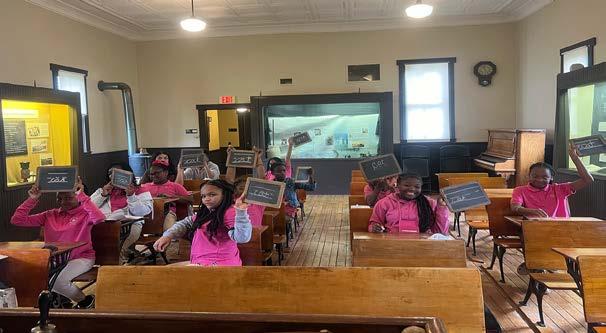

Contributors of this issue include the 2023-2024 Merze Tate Explorers.
Shi’Terriona Straham - Explorer Alumna
Purple Team: Pink Team:
Kaylee Hampton Kneveda Hightower
* Sasha Hollins Mya Mitchell
Madison Moore Nariyah Reynolds
Lena Richardson La’Niya Taylor
Akiela Taylor * Aliah Ward
Korie Pritchett-Evans Neveaha Ward
Green Team: Orange Team:
Kendall Baxter Kennedy Baxter
*Cianna Hobson Skylar Brown
Zydiora “Ziggy” Jones Nya Kuhn
Alayna Kuhn *Jasmine Liggins
Niyah Smith Juliana Liggins
Aaliyah Swift Alayna Swift
* Denotes Team Leader.
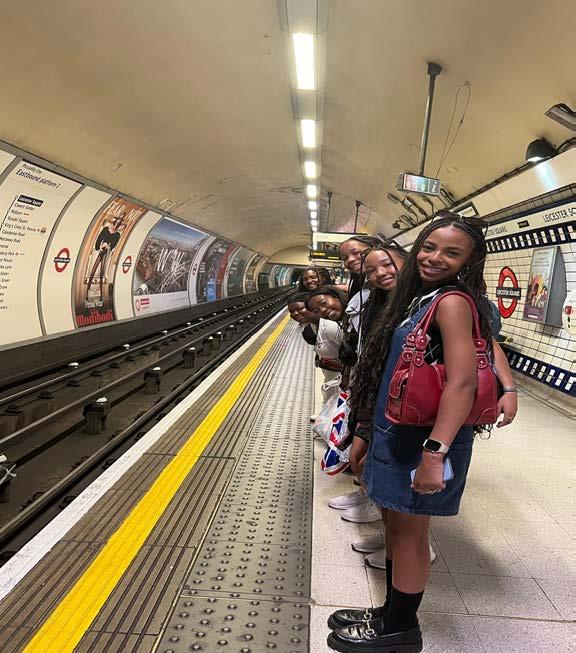
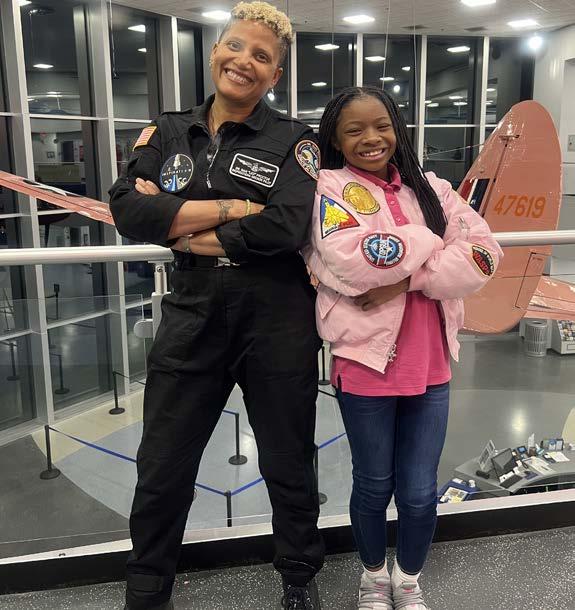
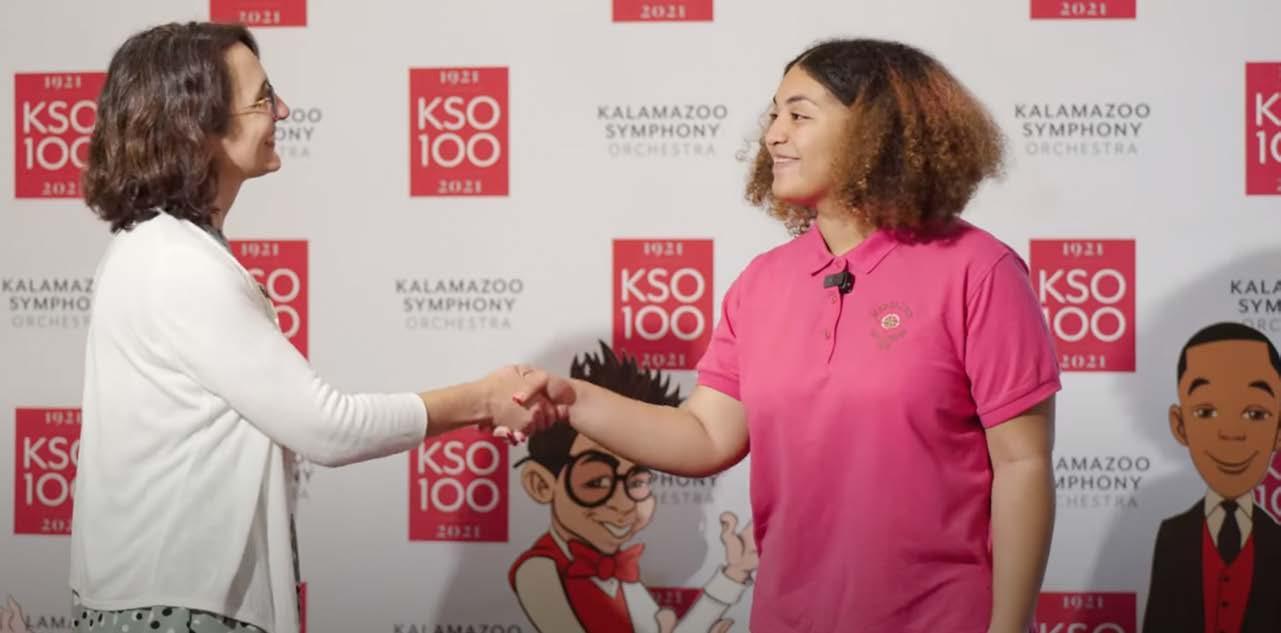
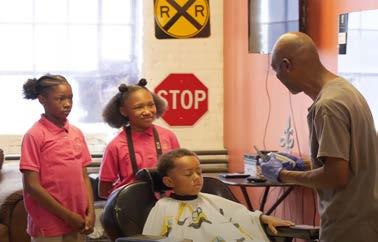
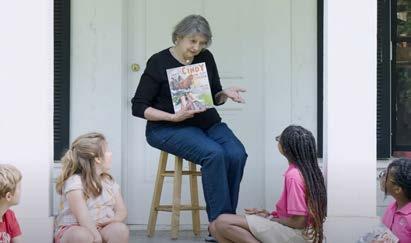
Thank you to our amazing partners in literacy for their sponsorship of the Community Book Bag project! Their support made it possible for Explorers to distribute 1,000 books in 250 book bags. Each bags was filled with four enchanting children’s books by local authors to young readers throughout Kalamazoo County, Michigan.
Our Explorers hand-delivered these special bags to students at daycare centers, schools, and even during the Saturday Family Program at the Kalamazoo Public Library’s Powell Branch. Each book, published in collaboration with Season Press, LLC (the parent company of Community Voices), highlights the rich tapestry of talent right here in our community.
But that’s not all! The adventure didn’t stop with the books. Our Explorers used their multimedia and reporting skills to create interactive visual adventures through QR codes included on the cover of each book. These videos take readers on a journeywith an Explorer that ends with a captivating reading by the author or a special celebrity guest.
Curious to see the magic for yourself? Head over to the Merze Tate Explorers’ YouTube page and dive into the stories that are inspiring our next generation of readers!






Explorers Sasha Hollins (left) and Aliah Ward pose with the activities coordinator of MediLodge nursing care located on Drake Road in Kalamazoo, Michigan. The Explorers assembled and distributed more than three dozen baskets to residents that each included a lap quilt made by Explorer volunteer Bette Boulding, an activity book, cozy socks, treats, and more.




The Merze Tate Explorers ended their 16th year with its annual celebration in partnership with Girl Scout Troop 80155, led by Cherise Ward and Nicole Barrow.
Nearly 100 family and friends joined the Merze Tate Explorers and the Bible Baptist Church Girl Scout Troop for their annual year-end celebration. The event, hosted by the Girls Scouts Heart of Michigan, celebrates a year of adventure and recognizes graduates and Scouts who advance to their next level during a Girl Scout Bridging ceremony.
Clockwise: Explorer seniors celebrate their upcoming college pursuits; Sasha Hollins, Aliah Ward, Alayna Kuhn, and Sanaa Olivacce-Shabazz pose with luggage gifts; Cherise Ward, leader of Girl Scout Troop 80155, welcomes Nevaeha Ward to the junior Girl Scouts as senior scouts look on; All Explorer and Girl Scouts celebrate another successful year.
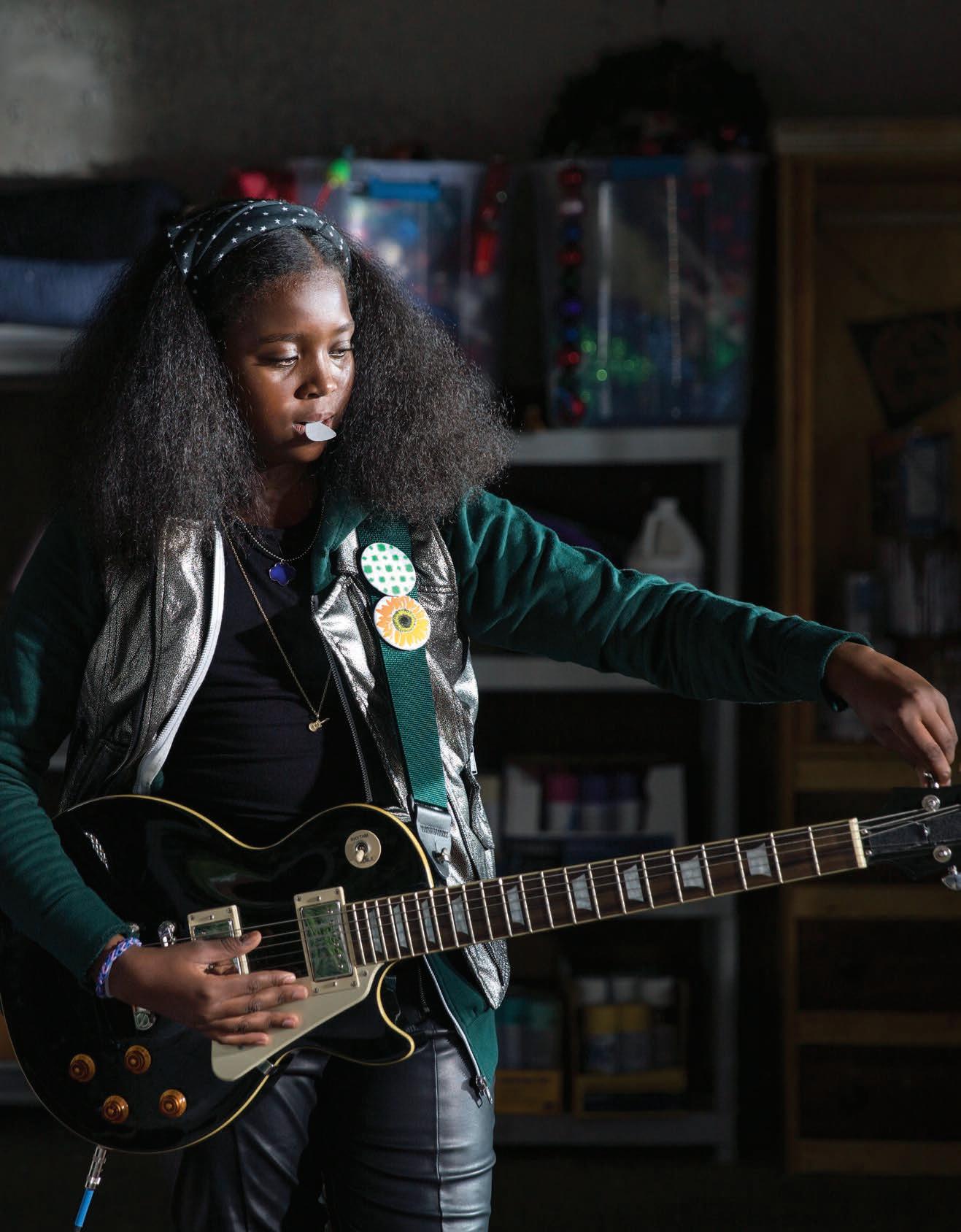
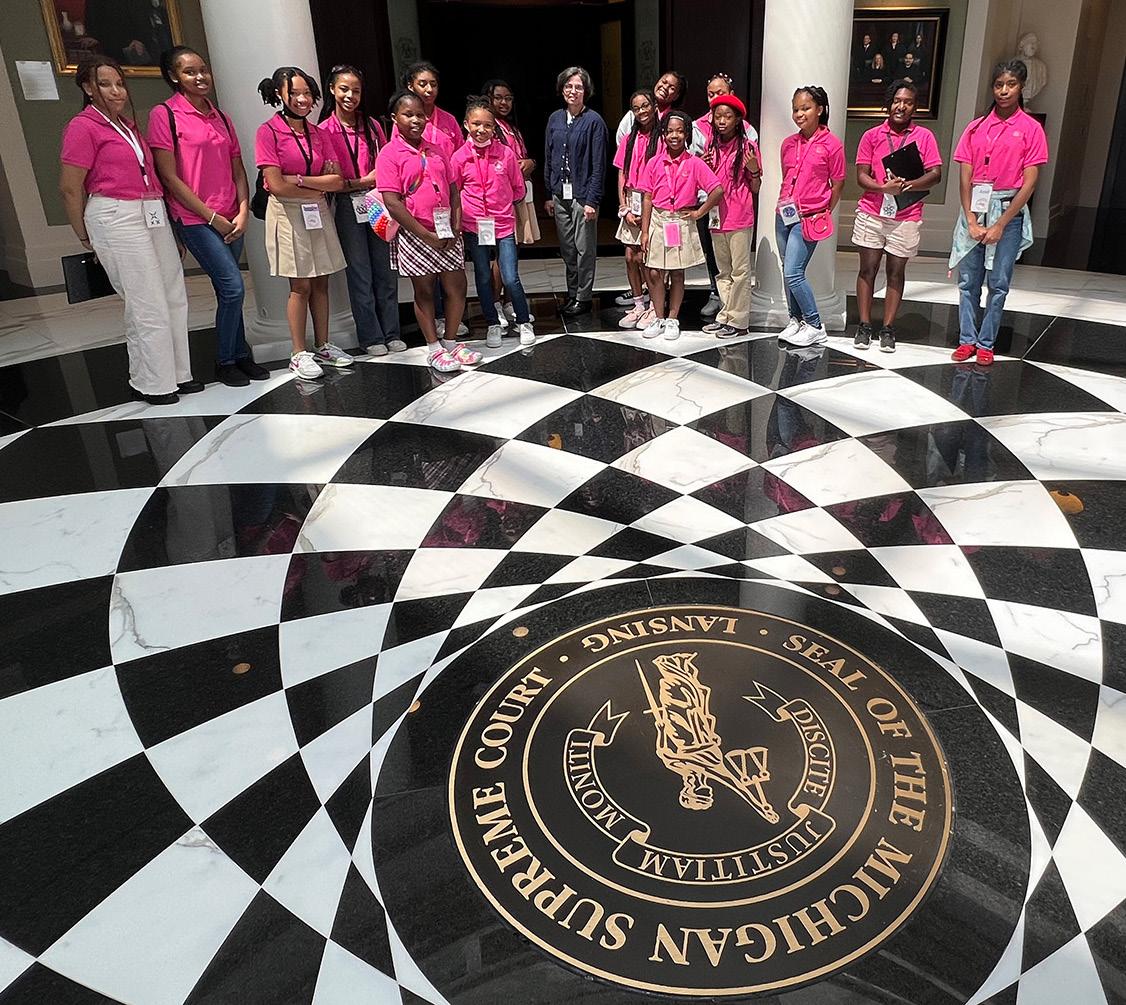

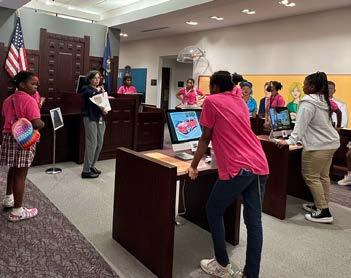
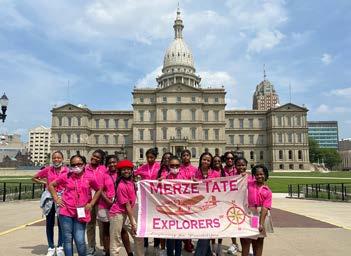
— The Merze Tate Explorers toured the Michigan Hall of Justice and the Capitol Building in Lansing, Michigan during their summer S.T.E.A.M. Academy. After an early drive to Lansing, we jumped out of the van for an amazing adventure.
We walked single file through security at the Hall of Justice. Rachael Drenovsky of the Michigan Supreme Court Learning Center, served as our knowledgeable guide. Drenovsky informed us about the executive, legislative, and judicial branches of government. We listened to her presentation and learned that the judicial branch includes the Supreme Court justices. Their role is to interpret the law and determine how it relates to a case.
We each took our places in a mock courtroom where we participated in a mock trial. The pretend case was about a neighbor who complained about the height of his neighbor’s new fence. Some Explorers served as the public, jurors, witnesses, lawyers, the defendant, the plaintiff, bailiff, and judge.
After the mock trial, we interacted with exhibits to better understand the history of courts and how they operate. We learned that a case first goes to the trial courts where the facts are reviewed. If the decision is not accepted, the case can then be moved to an appeals court. If the case still has not settled, it can go to the Michigan Supreme Court where final decisions are made.
One exhibit we visited discussed environmental law and how it “is a very large and complex part of the legal system at both federal and state levels.” We learned that it is illegal to pour hazardous materials into a storm sewer, among many other ways that environmental law addresses the amounts of chemicals in exhaust gasses, drain water, or solid waste that can hurt our world.
After lunch on the patio of the Hall of Justice, we walked across a long sidewalk to the Michigan Capitol building. With the help of our tour guide, Shayla Croteau, we learned about the building’s history, the artwork, and the 20 spectacular Michigan chandeliers. We had no idea that the first Capitol building was in Detroit, or that the building had so many motifs, like the word “Tuebor,” which means, “I will defend.”
The Michigan’s coat of arms was also on all the door hinges, and we learned that the building has sandstone exterior and 976 glass tiles that can hold about 40 tons!
During our visit, the building was under construction, but that didn’t stop us from learning about the current and past governors whose portraits hang in the gallery area. Both the Hall of Justice and Michigan Capitol are truly a wonder.
Above: Rachael Drenovsky, Learning Center coodinator, teaches the legal system and its Michigan history at the Hall of Justice.
Explorers pose in front of the State Capital before their tour.

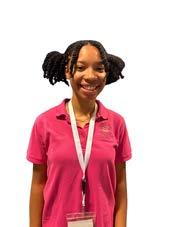




JUSTICE KYRA HARRIS BOLDEN

FIRST AFRICAN AMERICAN WOMAN ON THE MICHIGAN SUPREME COURT

“I had a mom who said I could be whatever I wanted to be...and I believed her.”
Jasmine: Could you tell us what led to you becoming the first Black woman on the Michigan Supreme Court?
Justice Bolden: I had a mom who said you can be whatever you want to be. And I actually believed her. And, the story of my great grandfather who was lynched in Tennessee in 1939, after asking a (white) store owner for a receipt. The coroner deemed it an accidental drowning. His murderers walked free. That’s what really prompted me to go to law school. I wanted families to see justice in a way that my family had not seen justice.
Congresswoman Brenda Lawrence (Southfield, Michigan) asked me to run for the Michigan Supreme Court. I (ran) because of my daughter. I didn’t know how I would look her in the face and tell her that I passed up an opportunity for representation on the Supreme Court. I lost the race…but was later appointed by Gov. Gretchen Whitmore (January 21, 2023) to fill a vacated seat.
Korie: Who are your mentors or people who impacted you the most growing up?
Justice Bolden: I’ve always had mentors that were not concerned with me surpassing them in any way, shape, or form. When I told a justice I once clerked for that I wanted to run for that position, he told me, “That’s perfect for you.” Judge Sheila Johnson has been one of my mentors and officiated my wedding. And, the partners of my law firm who allowed me to take leave to run for Michigan Supreme Court. I am incredibly grateful that there are so many people who have lifted me up as they climbed.
Juliana: What is the most challenging part of your job?
Justice Bolden: Learning my job while learning to be a new mom. When one ball is in the air, another one is dropping. So, I am still working on my work/life balance.
Skylar: What is your ultimate goal or dream?
Justice Bolden: I will always try to create space for other people and lift others as I climb. For now, it’s an honor to be in this space and uplift others throughout my life.
Madison: What are some of the places you would like to travel?
Justice Bolden: I would really like to go to Africa. I studied abroad in Japan, and I love the culture there. I would consider myself a little Explorer, too.
Jasmine: What advice do you have for girls interested in a career in public office?
Justice Bolden: When I first (campaigned), I was told I was too young. God will have an assignment on your life that people don’t understand. And you can not let other people’s limitations of themselves (or you), dictate your actions because some people will not be able to see the calling that is on your life.

Check out and LIKE the full interview on our YouTube channel!




FIRST AFRICAN AMERICAN WOMAN TO PILOT A SPACE AIRCRAFT
The Explorers sat down for an exclusive interview with astronaut Dr. Siann Proctor, a SpaceX mission pilot who spent three days orbiting earth. This in terview was made possible by the City of Portage and the Air Zoo. Thank you!

“It never entered my mind to be (afraid). I was excited to achieve a childhood dream.” Dr. Siann Proctor - SpaceX Astronaut
Lena: What are some challenges you faced during your journey to becoming an astronaut?
Dr. Proctor: One of the biggest challenges is the voice inside our head and how we talk to that voice. Because, a lot of times, that voice can fuel us with doubt. I told that voice, “I’m going to go, I’m going to have this experience, and I’m going to see how everything works. And, I went, and it was one of the best experiences I’ve ever had.
Sasha: We know that you have explored space, but what other places would you like to explore on earth?
Dr. Proctor: I love our planet. And the reason I became a geoscientist is because I love to travel. I made a goal to visit all 50 states and 50 countries before I turned 50, and I made it. Now, I’m working on now is the National Parks.
Kendall: How did you pack for space?
Dr. Proctor: I took a photo of my dad, who once worked for NASA, and my art supplies. They packed for us and our things were waiting in the capsule.
Kneveda: On a scale from 1-10, how afraid were you to travel to space?
Dr. Proctor: I was a 0! I was ready. I had wanted (this) my entire life. So when I was sitting there in that rocket, I was like, “Let’s Go! Light it up!”
Nariyah: What happens when the rocket lands back on earth in the ocean?
Dr. Proctor: After you splash down and the boat picks you up, then you get to get into a helicopter, and they helicopter you back to Kennedy Space Center. And, waiting for me were my siblings, and my best friends. They were all happy to see me.
Kennedy: Would you go to space again?
Dr. Proctor: I am very thankful for the fact that I did get the opportunity, and if I don’t go again, it’s okay. But, I wouldn’t turn down the opportunity if it came my way.

Check out and LIKE the full interview on our YouTube channel!


The Explorers interviewed author Isabel Estrada to learn more about the author. After her interview, girls created their own children’s book story. Thank you to the Kalamazoo Public Library for hosting our day with an author.




“In life, you are not just one thing. There are many aspects of who you are in your personality. This book represents for me all the different ways you can melt who you are into something creative.”
Isabel Estrada - Internationally Recognized Author
Juliana and Ziggy were lead reporters in an interview with Kalamazoo-based author Isabel Estrada at the Kalamazoo Public Library. Estrada’s debut book, La Mariachi, was published through Sleeping Bear Press and represents its Own Voices, Own Stories series.
Ziggy: What is it like being an author?
Mrs. Estrada: It’s wonderful. It’s a dream come true. The minute you begin writing, you are an author and a writer; you don’t have to be published to be an author. But the dream of having a published book is really special.
Juliana: Why did you make this book?
Mrs. Estrada: When I was a little girl, about 9, there was a group in my town (Tuscan, Arizona), for Mariachi, but it was only for boys. I love music and wanted to become a musician. In writing, I remembered what it was like to be left out. Writing to my passion, I realized I hadn’t put my love for music and writing together, and that’s how this book came about. Mariachi ties me back to the celebration of who I am.
Ziggy: When you were little, did you think you would become an author?
Mrs. Estrada: No, I wanted to become a famous singer.
Cianna: When did you decide that you wanted to make an impact in the world?
Mrs. Estrada: I grew up loving music. I’m from a musical family, and my whole life has been filled with music. In high school, I said
I wanted to be creative. I became a teacher of the arts and a singer. As a mom, I fell in love with children’s picture books and would use music in the classroom when I read to my students. Then, I realized I could use music, words, and poetry, the things I loved, to write books.
Skylar: You said you were a teacher. Where have you taught?
Mrs. Estrada: I graduated from the University of Arizona and earned a master’s degree. I later taught teachers at the university how to teach art. I also taught at Bowling Green State University and Central Michigan University.
Lena: What obstacles did you overcome to write the book?
Mrs. Estrada: I submitted a book to Sleeping Bear Press “Own Voices, Own Stories” contest. I didn’t win, but they later called to say they wanted to publish my book.
Skylar: How many books have you written?
Mrs. Estrada: I am working on 55 children’s books, some middle grade books and novels. These are projects that I keep revising until they are ready to submit to agents and editors and hoping the universe opens its arms and welcomes my books.

Check out and LIKE the full interview on our YouTube channel!

By Kendall, Kennedy, and Madison

MT. PLEASANT, MICHIGAN — Each Explorer received a personal chalkboard with a piece of chalk. Our guide, Rebecca Petrone, asked Nariyah to grab socks from a wash bucket and hand one to each of us. We laughed—why would we need a sock?
“You need a sock to use as an eraser for your board,” said Petrone, a museum educator and technologist at Central Michigan University. We learned that students in one-room schoolhouses had to use whatever they had to make their education work. During our monthly Mystery Trip adventures, the Merze Tate Explorers visited the Bohannon Schoolhouse and Gerald L. Poor Museum.
Petrone has worked at the one-room schoolhouse since 2021. She was a former student and graduated from CMU. She explained that the original school would have had one teacher who
taught students from kindergarten through 12th grade, all in the same room.
One-room schoolhouses were most common up through the 1950s. The Bohannon Schoolhouse, named after the Bohannon family, was built in 1901 in Jasper Township, near Midland, Michigan. Records show that during its 49 years of operation, there were as many as 38 students, while in some years, there were fewer than ten. The school was moved to its current location at 103 Rowe Hall on CMU’s campus in 1970 and is now a museum. The CMU trustees named the museum’s interior in honor of Gerald L. Poor, a professor of secondary education who taught at the university from 1943 to 1973. Petrone said Poor cared deeply for his students. He passed away in 1973 before the schoolhouse was dedicated to him in 1976.
Most children who attended one-room schoolhouses came from farm families. School started later than it does today because many kids had to walk long distances after doing chores like making their beds or working on the farm. School began as late as 9 a.m. and ended at 2:30 p.m. for younger kids, and as late as 4 p.m. for older students.
During recess, students played games like tag, Duck-DuckGoose, hide-and-seek, Marco Polo, jump rope, Kick the Can, Sharks and Minnows, and more. They brought their lunches in small pails, which usually included vegetables, fruit, and other things from their farms.

One-room schoolhouse schedules included the same subjects we have today, like math, English, geography, music, and story time, but they also focused on cursive/penmanship, spelling, and hygiene. According to Petrone, “Students had to use an old dictionary or catalog paper as toilet paper in the outhouse when they needed to use the bathroom.”
Teachers handed out harsh punishments to students who misbehaved. If a student wasn’t paying attention, they had to sit in a corner wearing a dunce cap. Teachers could hit students on the knuckles with a stick or ruler if caught sleeping in class. If caught chewing gum, students had to stick it on the chalkboard and press their noses against it until they were allowed to return to their seats.
Before colleges or Normal schools existed to educate teachers, single women from town were often selected to teach. According to Petrone, “One-room schoolhouses are important because while bigger cities had larger schools, rural towns didn’t, and they were part of the Common School Era.”
Schools today are much different than they were back then. Communities now have multiple schools with running water, indoor bathrooms, computers, and separate classes for each grade.

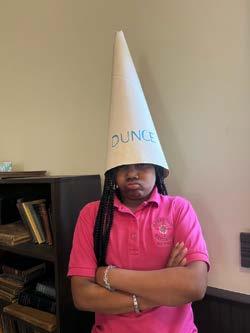




Left page: Madison and Kendall show the class schedule; Above clockwise: Kendall, Kennedy, and Madison have fun with old-fashioned chalkboard; Students pose in front of the Bohannon Schoolhouse; a Sears catalogue was used for the outhouse; Rebecca Petrone shows a stick teachers may have used to hit the knuckles of disobedient students; Korie poses with the class Dunce hat; Lena demonstrates having her nose stick to gum on a board, a punishment for those chewing gum in class.





mylifebygivingme opportunitiesnoother organizationcouldhave . providedExplorer2008-2024
Class of 2024
Gull Lake High School, Richland, MI
College: Kalamazoo Valley Community College
Future Career: Elementary Education
First Explorer memory: Sleeping in the dorms on Kalamazoo College’s campus during a summer academy. Aliah was my roommate. We technically weren’t old enough to be Explorers, so we received special shirts.
Most exciting Explorer interview: Astronaut Mae Jemison inspired me to realize that there are no limits to what I can do.
Most exciting Explorer travel: Tanzania! My mom and me really connected as we climbed Mt. Kilimanjaro.
How has Merze Tate’s life inspired you:
She never let anyone hold her back. She wasn’t afraid to explore the world.














I a grateful for the skills and memories I obtained as an Explorer and can’t wait to use them in my future endeavors. Explorer 2013-2024
First Explorer memory:

Going to the Barn Theatre and learning a sword fight scene from Peter Pan play. We had the opportunity to go behind the scenes and see the “pretend” alligator open its mouth.



Class of 2024
Loy Norrix High School, Kalamazoo, MI
College: Western Michigan University


Most exciting Explorer interview: Monique Grayson and her go-getter attitude to become a pilot intrigued me. I love how passionate she was about her career and she inspired me to pursue my passion in the medical field.
Most exciting Explorer travel: Hawaii was a very exciting place for me to visit because of the beautiful agriculture and water. I enjoyed journaling and taking pictures there.
How has Merze Tate’s life inspired you:

Going to the Barn Theatre and learning I her from she

Future Career: Medicine (Pediatrician)
She never let the color of her skin stop her from achieving her dreams, and she helped so many people while doing it.




As an Explorer, I have learned so many different skills that I have used and will continue to use. For that, I am eternally grateful. Explorer 2015-2024
First Explorer memory:


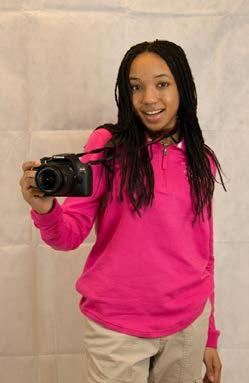
Class of 2024

Staying on a college campus at an early age gave me a sense of independence and freedom. Now that I am starting to embark on my college career, I am going in with a feeling of familiarity, and not many incoming freshmen can say that.
Most exciting Explorer interview: Astronaut Mae Jemison encouraged me to be ambitious. I learned more about her drive and determination, which were important to her success.
Most exciting Explorer travel:
The climb to Diamond Head in Hawaii was the pinnacle of our trip there. I didn’t realize how far I had climbed until we reached the top. This goes to show that with the right people by your side, obstacles don’t stand a chance.



Salem High School, Canton, MI
College: Michigan State University
Future Career: Sports Medicine (Kinesiology)
How has Merze Tate’s life inspired you:
One big lesson I learned from her life is that there’s always an opportunity to grow and learn new things—you just have to go out there and seek them.






The Merze Tate Explorers shaped me into the person I am today - a person unafraid to dream body, love fiercely, and embrace every facet of my beautiful, Black girl magic. Explorer 2016-2024

First Explorer memory: On my first day of overnight camp at Kalamazoo College, I found sisterhood in girls who looked just like me...so many who are now lifelong friends.
Most exciting Explorer interview: I found Ambassador Harriet ElamThomas the most interesting. Her tales of working on and experiencing U.S. diplomacy at such a high level was inspiring. I’ll never forget the words or encouragement she poured into my 12-year-old self.
Most exciting Explorer travel: Hawaii, easily. After returning from the beach in Waikiki, Sasha, Alayna, Aliah, and I were all sandy and tired, yet happy to talk about whatever 12-yearold girls talk about. It makes me proud to have them as friends almost a decade later.
How has Merze Tate’s life inspired you: Her journey from segregated America to becoming the first African America graduate of Oxford University teaches me to pursue my dreams fearlessly.




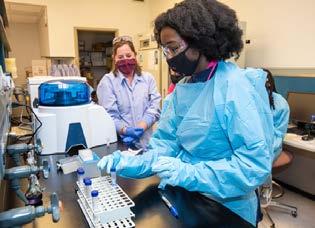
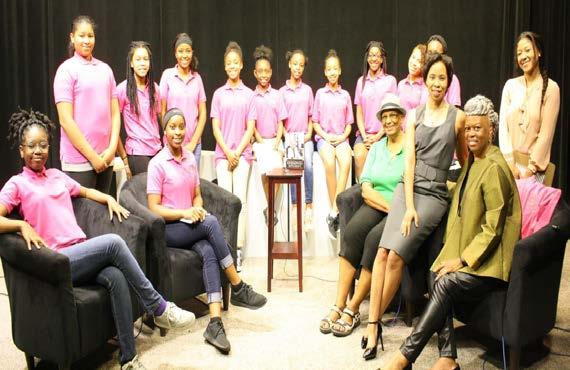


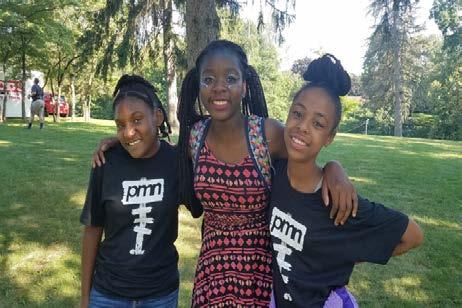














Our first day in London was a thrilling adventure as we embarked on the famous Hop-On Hop-Off bus tour and riverboat cruise. The city came alive from the top of the bright red doubledecker bus, and we felt like we had stepped into the pages of an interactive history book. The morning air was cool and crisp, the streets were lively, and everything just felt right.
The Hop-On Hop-Off tours in London consist of a series of buses with different routes that guide you around the city. Buses allow tourists to “hop off” at various stops to spend time in a specific area. Then, when you are ready to continue your bus tour, you simply wait at the designated stops and “hop on” to continue your journey.
We had a perfect view of the city and took advantage of it for photos and videos. During the tour, a pre-recorded voice spoke to us through our headphones, explaining where we were and the significance and history of each place. I found this to be incredibly helpful. It allowed me to take my eyes off the map and truly absorb what was right in front of me. Our bus was on the Yellow route. It took us to see some of the most known places and landmarks throughout London, such as the Tower of London, London Bridge, and the Westminster Pier.
I eagerly snapped pictures and videos of each place I found interesting, mostly all of them. However, I would say that I had a hard time balancing sightseeing and photography. I really wanted to live in the moment and just experience what I was seeing. On
building; Royal Court of Justice; a view of London from the London Bridge.
the other hand, there were so many beautiful opportunities for photos and videos, which resulted in great memories to share for my article and reminisce about in the future.
All the places we visited were incredible, but the one that solidified the fact that this was a surreal experience was seeing Big Ben. This is one of the iconic monuments many think of when they hear the word London. It is probably the one I’ve seen the most throughout my years of learning of this landmark as an Explorer. To go from being able to identify Big Ben quickly during our landmark tests to actually seeing it was extremely eye-opening. It instantly made me appreciate this opportunity on a whole different level.
After a couple of hours, we took a break to eat lunch and prepare for a boat cruise along the Thames River. Our river cruise added a new perspective to the city’s culture and history. The boat captain used comedy to share fun facts about London and its old and new cultural sites. This also gave us a chance to see a closer view of some bridges and other buildings.
Our guided tours in London provided us with a unique perspective of the city’s history and culture. The Hop-On Hop-Off tour and river cruise, each in their own way, enriched our understanding of London and set the stage for the days to come.

“Her resilience reassures me that I am not alone in my struggles and that I can overcome them, no matter how challenging they may be.”


Aliah Ward


Story by Aliah Ward
OXFORD, ENGLAND —While voyaging through London, the Explorers visited Oxford University, Merze Tate’s alma mater. To travel to Oxford, we took the underground subway from Kings Cross St. Pancreas near our hotel to Paddington Station. Our group missed the first two trains because they were overcrowded due to an earlier train delay, but we made the third train, which was about an hour’s ride to the town of Oxford.
Once I set foot in the town of Oxford, I strolled excitedly down the streets with a camera in hand. I couldn’t help but stare in awe at the surrounding beauty. Oxford is its own little secluded town, with local businesses, restaurants, shops, and so much more. There is a mix of historic architecture, modern buildings, and shops like Shake Shack and Toys R Us. As I navigated through the town, I imagined Merze Tate stepping off a train in 1932, anxious about being a student at the world’s oldest university. I spent most of my children as an Explorer learning about this prominent historical figure. Walking down the same streets and viewing the same astounding architecture as Tate did felt surreal.
Although we were at the same location, my enthusiasm may have differed greatly from Tate’s ambiguous feelings about her future at the historic university, especially because she would soon find out that she was missing two vital aspects of admission.
The wonderful staff at Oxford shared with us what life was like for Tate at Oxford. They shared her original school files, which included her enthralling letters. She was a very spirited yet demure young woman, who was treated with much respect and dignity. We learned that, even before being admitted into Oxford, Tate arrived on the campus in England with no place to stay. While she had been accepted to St. Anne’s College (the school for Oxford women), she had not technically been enrolled. The college admissions process was different back then, with applicants having to first reach out to the college via letter accepting the admission, and then take an entry exam.
Tate arrived on campus before even taking the entry exam! She sent a letter in April 1932 to The Office of International Relations as standard for the admissions process. However, she had so much confidence to pass the exam that she traveled to Europe without certainty of admittance or residence.
Because she had not taken the exam to secure her focus of study, she had not been assigned lodging. Being the intelligent women she was, Tate passed the exam but took classes in Economics just to begin taking classes. She didn’t care; she just wanted to get started.
Tate was not afraid to voice her opinions and feelings through her writings. Despite being purposeful in her letters, she also had a very “elegant writing style” as Explorer Sanna Olivacce- Shabazz described it. Reading these letters brought Tate’s world to life, and helped us view her from the perspective of a living, breathing person, and not just someone we had grown to know through her photographs.
The historians of St. Anne’s College (now the university’s library) gave us an exclusive presentation on Tate’s life. They included Matthew Chipping, archivist, and Clare White, librarian. We were also joined by Kiri-Ann, Deputy Director of Development, and Emily Perkins, Development and Communications assistant.

During the presentation, White and Chipping shared the history, cultural and social standards held at Oxford University during Merze Tate’s time. I found it most interesting that women had to have chaperones to go anywhere outside of their shared apartment building, and were required to be in their rooms by 11p.m. Merze Tate had been on her own since around 14 years old when she first moved to Battle Creek and worked as a maid to complete high school. Despite this, she was still required to follow these rules.
One of the letters Tate wrote discussed why these rules so were preposterous. When Tate’s “guardians” left, the college urged her to find someone else to “care” for her. In turn, she decided to write about how independent she was, given her background and travel experience. Nevertheless, she still had to have a chaperone, but raised an important question about gender norms that changed in the future.
Despite the success we know of Tate as the first African American to earn a degree from Oxford University (1935), she encountered many obstacles during her schooling there. During her first dissertation, Tate fractured her foot in a bike riding accident. White says, “She was really determined that she carry on and that she complete her thesis. And she did this while her foot was, you know, in a ton of pain.” In one of her letters, Tate talks about how her accident caused her to miss school since she had to stay at a nursing facility near the campus. Because of her absence, a staff member vouched for her, saying that Tate was still doing schoolwork and was on track to graduate.
After finishing her dissertation, Tate traveled throughout Europe in the summer while awaiting approval to graduate. She discovered that her thesis, as White shared, “Looked at too many things…almost too enthusiastic.” Tate was advised to return to Oxford to get help from a tutor to rewrite her dissertation. This
was disappointing to Tate as it would not allow her to graduate in one year, as she hoped.
Upon hearing this detrimental news, Tate writes a letter on June 15th, 1934, to Miss Hadow, a tutor and mentor, about her struggles and feelings of “failure.” She felt she had let the African American community down, stating: “There are hundreds of coloured women in America who would have come up to Oxford and be successful… please remember this when you are considering future candidates.” She added that it was “the first great failure of my life but I am anxious that others should not suffer because of my failure.” When reading this statement, I connected to the authentic and widely known fears Tate experienced as a pioneering Black woman. Although she was disheartened, Tate wrote a second dissertation and found funds to continue her studies at the university. After nearly three years at Oxford, she graduated with the help of staff members.
After the presentation of new information about Tate, I realized that such an accomplished woman as Tate had the same doubts about her work and impact on her community as many of us have. Her resilience reassures me that I am not alone in my struggles, and that I can overcome them no matter how challenging they may be.
Immersing myself in Merze Tate’s life at Oxford was such a coming-of- age experience for me. I truly appreciated being able to see her old residence, recreate her cap and gown picture near the Bridge of Sighs, and learn some amazing facts through her letters. Having exposure to some of the same things my role model did decades ago helps me understand more about myself and my place in the world. Tate is such an impactful female figure. There are so many chronicles about her that are still waiting to be unraveled. The accomplishments of Merze Tate’s life will continue to be told for years to come. And, each story will inspire us to follow our passions and never give up.


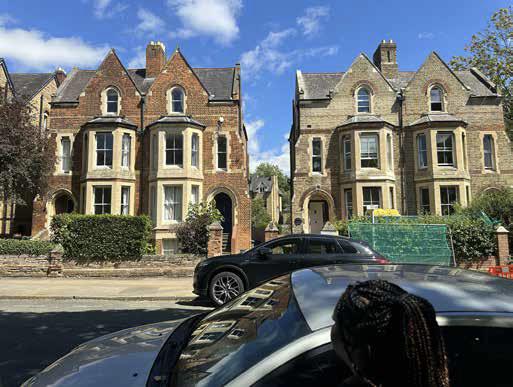
Be rectified. The great pity is that in the final analysis – and in simple language – I have failed.
What I now want to ask is, of course, too much to expect, but nevertheless, it would not be fair to others if I remained silent. I do hope that you will try to forget that I was ever a Home Student and that I ever existed. I beg this of you because I do not want you to use me as a standard for judging others of my race. ...If ever another young coloured woman should apply to come up to Oxford I hope that you will judge her on her own merit and not think of me and all the trouble I caused.
Letter from Merze Tate to Miss Hadow, June 15, 1944, after learning she failed her final exam. Courtesy of St. Anne’s Library - Oxford University.



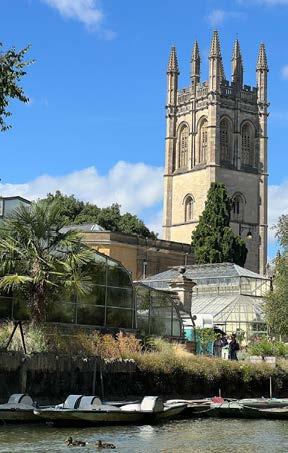
OXFORD, ENGLAND—Have you ever heard of punting? When I first learned that we were punting in London, my first thought was football, like when the kicker “punts” the ball. Boy, was I wrong!
Punting is when a boat is guided by a person (punter) with a long pole that goes into the canal to push the boat. They lift the pole and back down to continue “punting” along. I was so excited because it would be my first time on a boat ever! To top it all off, knowing that Merze Tate also went punting back in the 1930s while she was a student at Oxford made it even more exciting.
On our third day in England, we woke up bright and early at 6:00 a.m., rushing to catch an underground train to Paddington Station. There, we would connect to a train to Oxford, where we would meet Oxford University historians and go punting.
Once at Paddington Station, we noticed our train to Oxford was about to arrive on Platform 6. We gathered our group and realized a few kids had gone to Starbucks. Oh no! When they returned, we nervously sprinted to the platform where the train was departing. We were all out of breath but laughing at the same time. And guess what? ALL THE CARS WERE FULL! Not just the seats on the train, but the WHOLE train was packed with people standing practically out of the door.
So we had to wait for the next train, and we waited near the front of the line (bonus tip from a really nice employee). We eagerly got on the next train and rode it for about an hour to Oxford. After one of the most amazing presentations I have heard about Merze Tate (see Aliah’s story on page 25), we headed to the Magdalen Bridge Boathouse on High Street for our punting experience. The walk from the campus to the boathouse was 20 minutes, and we had about 15 minutes to speed walk to get there in time (remember, the train set us back an hour!)
We met with our punting guide, Evie. We learned that she is a student at the University of London, where she studies fashion and works at the boathouse during the summers. Trying to get in the boat was a little tricky because it rocked as we stepped inside. We didn’t want to make the boat tip over because we had our phones and cameras.
Once everyone got settled and ready, Evie started our tour. She was very cool! She had an awesome English accent and was very interesting. During the tour along the River Cherwell, she told us different facts about punting and what we would see on the river. To guide around the river, she used a metal pole. She would lift the pole in and out of the water in a pushing motion to maneu-
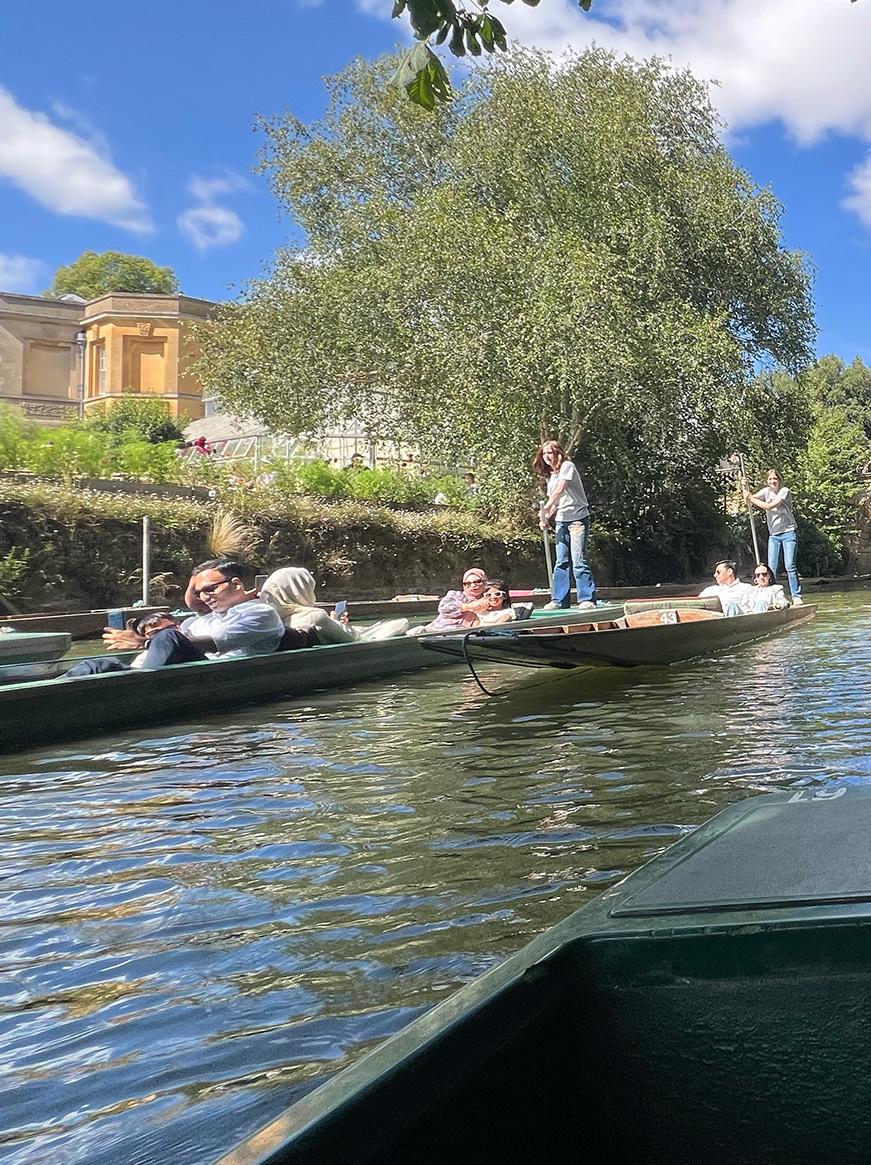
ver the boat around the river. She mentioned that heavier poles and the number of passengers make punting harder. Sitting on the boat felt very relaxing. I took many pictures of the scenery and the ducks that paddled up to the boats in hopes of getting a treat. I felt very close to nature, and my mind felt peaceful.
The water was cold, and the breeze was comforting. The temperature in the air was perfect. We could see a lot of the structures and landscape around the river, which is a very interesting and unique way to tour the area. We saw Christ Church, one of Oxford’s 36 colleges that also contained the Cathedral of the Oxford diocese. We also saw the Botanic Garden.
During the ride, my mind sometimes drifted off and thought about how Merze Tate traveled this same river. I thought about how it would be really cool to ride in the boat with her. I can imagine her sitting with perfect posture, her legs crossed, and her journal out. She would write her thoughts in perfect penmanship, using this peaceful time to decompress. I wish I would’ve had my journal at the time. It seems like the perfect place to relax and unwind.
I really loved the 30-minute ride around the river. It’s cool to have experienced something unique, and I have a lot of memories to share with my friends and family. I would highly recommend punting during a trip to Oxford.



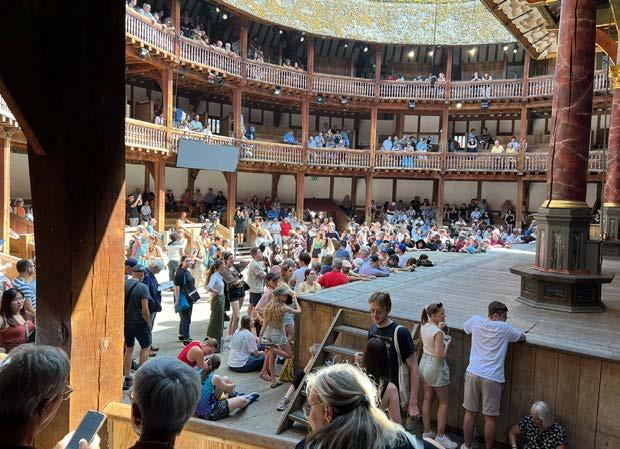

LONDON, ENGLAND—The humid, thick London air inside Shakespeare’s Globe Theatre buzzed with excitement as everyone—from the stage crew to concession workers—prepared for the performance of Antony and Cleopatra. Theatergoers fanned themselves with programs in an attempt to battle the heat. Yet, the warmth couldn’t diminish the shared sense of joy before a production. Then, in the blink of an eye, the stage lights slowly rose, a low, heavy drum began to pound, a woman in medieval dress conducted a small brass orchestra, and the show began.
Our day at the Globe Theatre began with a tour led by our guide, Michael Downey. Downey, a New Zealand native, is an actor who has directed, performed, and studied Shakespeare, Western acting, and its historical context. He led our group with wit and a vast knowledge of Shakespearean history. He explained that modern Western acting, as we know it, began in early Elizabethan England, just beyond the Thames River, on a street known as North Wall. Many playwrights of the time, including Shakespeare, were starting to use theater in a more recreational, storytelling, and sometimes political way, moving away from its traditional role as a religious medium. This shift, however, led to the theater being associated with more “adult” activities, alongside brothels, pubs, and bear-baiting (a medieval sport where a bear was chained to a stake and made to fight angry bulldogs).
Downey also shared that the Globe Theatre we tour today is in a different location than the original. The first Globe was built in Bankside, Southwark, in 1599, and had a successful run until June 29, 1613, during a performance of *Henry VIII*. That night, small cannons fired gunpowder with wadding that got stuck in the thatch
ers
the steps
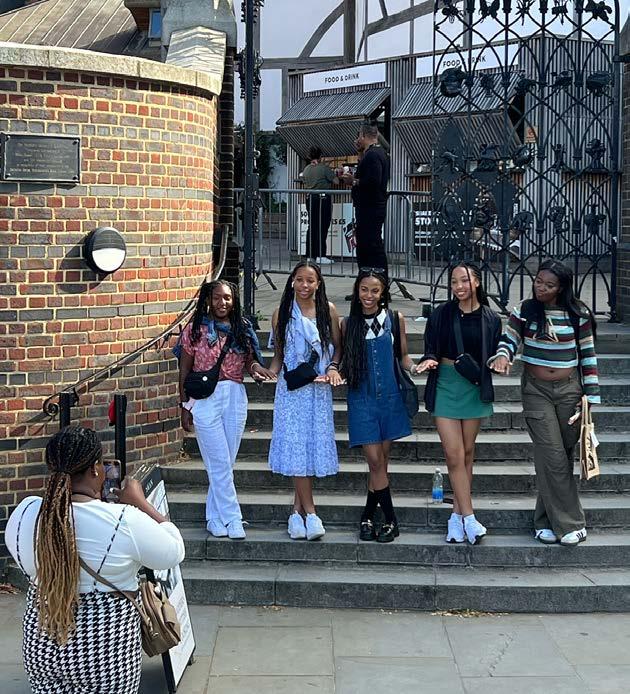
roof, setting the theater on fire. It wasn’t until 1997 that the Globe was revived, thanks to Jewish-American actor and director Sam Wanamaker. The modern Globe Theatre is a full-scale replica of Shakespeare’s original 1599 open-air theater and includes the Sam Wanamaker Playhouse (opened in 2014), a model of the indoor, candle-lit Jacobean theater.
After learning all of this, we were led to the amphitheater, where we discovered the theater’s seating arrangements based on ticket prices. “The Yard” was the cheapest area, where people stood to watch plays. It was unique because it led to more interactive experiences with the production, like heckling or throwing food at the actors. We learned that original Shakespearean sets were sparse, requiring the audience to use their imaginations— something still true in the *Antony and Cleopatra* production we saw.
Though I initially disliked reading Shakespeare in school or learning his monologues for auditions, I now realize how much more there is to the world of Shakespearean theater than I ever imagined. The Globe Theatre, with its rich history and vibrant atmosphere, is not just a place to watch plays; it’s a living, breathing testament to the enduring power of the arts. As I left the theater, I felt a renewed sense of connection to the craft I love, inspired by the performances and the dedication of those who work to keep Shakespeare’s legacy alive. My experience at the Globe reaffirmed my passion for the arts, reminding me that in this ever-evolving world, some things—like the magic of a live performance—remain timeless.

WILTSHIRE, ENGLAND —If someone had told my 7-yearold self that I would see Stonehenge one day, I would not have believed them. I had seen the image of these huge rocks since the third grade when I became an official Explorer. An interesting group of mysterious stones is one of the 20 landmarks we learned about and hoped to visit one day. It was one of the places I thought I would never get to see outside of the laminated flashcards we practiced each year. But, during our senior study abroad in England, seeing Stonehenge became one of my best experiences.
During the first two days of our stay in London, we often struggled to meet for breakfast. But on our Stonehenge day, everyone was out the door and ready to go on time. But, while we were on time, we arrived at King’s Cross St. Pancras Underground Station, a block from our hotel, to the sound of alarms. A station police locked the gate, leaving us and dozens of other passengers scrambling for cabs and buses to get them to their destinations. Protests had been happening in London; was it related? We didn’t have time to find out. We had to think of a Plan B quickly to make it to the coach station in time for our bus to Stonehenge.
Our guide, Jan Latham, considered the city buses, but we couldn’t find the stop leading to Victoria Station, near the coach station. Plan C led to us hailing two taxis to take our group of nine to our tour bus location. Whew! We made it with five minutes to spare before boarding at 8 a.m.
We were told that it would be a two-hour drive to Salisbury Plain in Wiltshire, so the Explorers and the other two dozen passengers took a nap. Once we arrived on that chilly morning, I could feel a mix of anticipation and apprehension bubbling within me. What seemed like just a bunch of huge rocks would captivate us for nearly two hours.
The reality of the weather struck me hard. It was a gloomy day, and a biting wind cut through the air with a sharpness. As we approached the site, the first thing that struck me was the sheer number of people. Our flashcard photo had given us the impression that Stonehenge was always void of any humans. The area was swarming with hundreds of stone seers from across the world whose breaths were visible in the chilly air. Children clung to their parents, their faces flushed from the cold. Adults braved the weather, some even in short sleeves and T-shirts. I figured they were either used to cold weather or just extremely unprepared.
I would soon learn just how interactive the tour of the stones would be. The first interaction we had was when we were told to download an app to listen to little audio portions while circling Stonehenge. As I listened, I reached the viewing area, where the full majesty of Stonehenge unfolded before me. The colossal stones, their gray surfaces weathered by centuries of wind and rain, stood defiantly upright and proud. I could hardly believe I was finally there, standing before something that the audio narrator said had been around for over 4,500 years.

I learned that Stonehenge’s origins have long been the subject of speculation. Constructed in stages, it began as a simple earthwork enclosure around 3100 BC, with the stone circle itself taking shape around 2500 BC. The massive sarsen stones, some weighing up to 25 tons, were transported from the Marlborough Downs, about 20 miles away, while the smaller bluestones came from the Preseli Hills in Wales, nearly 200 miles distant. The work involved in its construction showed the ingenuity of its builders, who sought to align it with the movements of the sun and moon. This was all interesting, as I have never actually known the backstory behind Stonehenge.
As we continued around the monumental display of stones, we stopped for more interactive photo ops. They were very fun and creative, and I loved seeing and hearing all the different languages of people directing their friends and families to get their fingers perfectly on the top of Stonehenge so it looked like they were touching the stones.
The two hours at the historic park went by quickly. My heart was full as we boarded a shuttle from the stones to our awaiting bus. Stonehenge had occupied my thoughts for a decade.
If I were asked if I would see this beautiful landmark again, I’d honestly say No. But I wouldn’t say that to the thousands who visit Stonehenge for stargazing, meditation sessions, and other activities throughout the year. For me, it was a way to experience one of the landmarks Explorers had wanted to visit since the organization began in 2008. Now, we can check it off our list and look forward to other Explorers who will go on adventures to other destinations we have dreamed of visiting.



By Shi’Terriona Straham - Alumna
LONDON, ENGLAND —Going to London and seeing the Tower Bridge, London Eye, Oxford, and Stonehenge was one of the best experiences I’ve ever had. The environment was incredible and so different from what I’m used to. Everyone seemed to always be in a rush, constantly running to catch trains and speed walking down the streets. At first, I didn’t understand why, but after our second day, I realized there was so much to see, and moving quickly helped us get the most out of the experience.
I wondered how Merze Tate felt when she walked those very same streets. I thought about the differences and similarities be-
tween the London I experienced in 2024 and the London she experienced in the 1930s as a student at Oxford’s St. Anne’s College.
The historians at St. Anne’s Library (originally the home of St. Anne’s College) curated a special presentation about Merze Tate just for us. We saw her academic files and handwritten letters from her time there, which really helped me understand her determination. Reading her letters to college officials about her academic and financial struggles made me realize that sometimes we have to work harder to get the outcomes we want. But as long as we’re confident in our abilities and ourselves, we can accomplish anything we set our minds to.






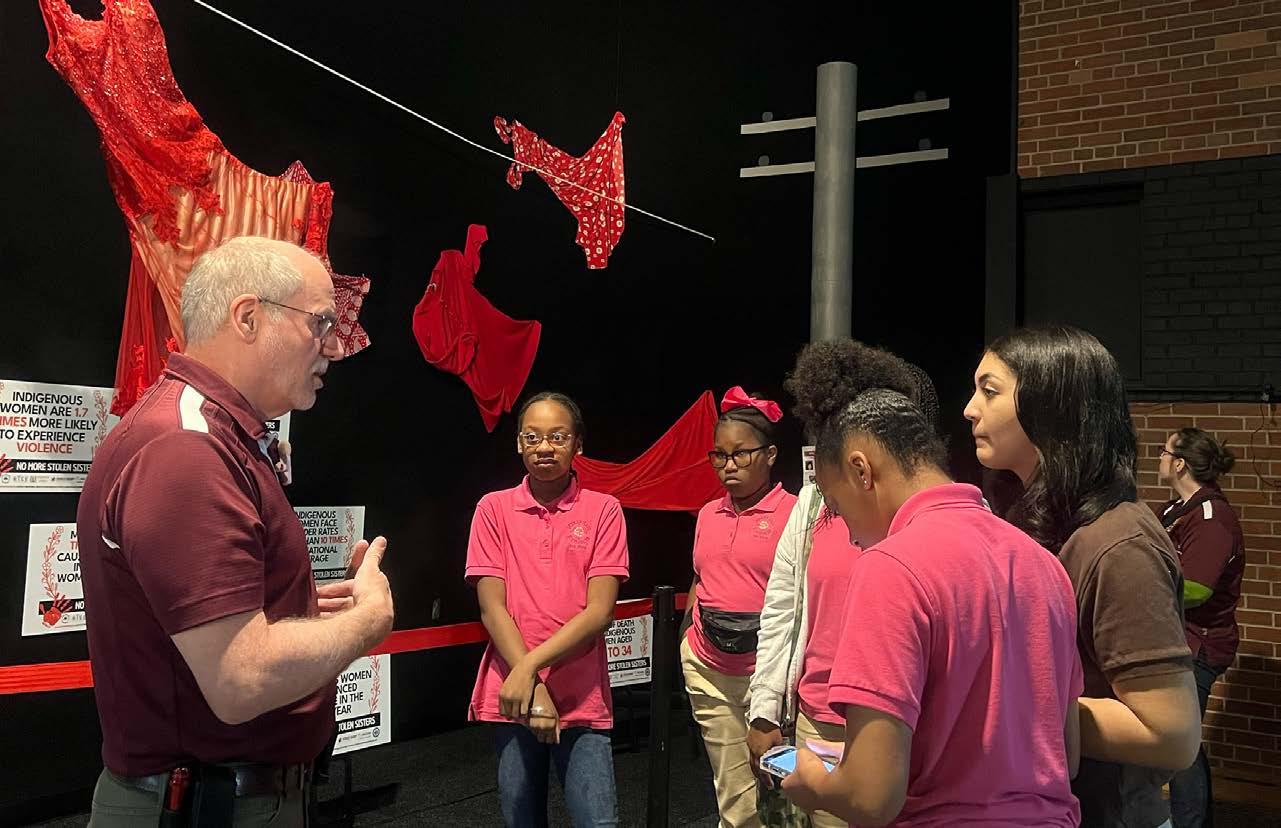
By Ziggy Korie, and Cianna
MT. PLEASANT, MICHIGAN —Homicide is the third leading cause of death for Indigenous women ages 10-24. When a taxidermist stuffs an animal, they remove its eyes. The Old Settlers had an interesting history in Michigan. These are some cool facts we learned at Central Michigan University’s Museum in Rowe Hall on the Mt. Pleasant, Michigan campus.
The Explorers visited the museum during their monthly mystery trip weekend to learn more about Merze Tate and her family history. Thanks to museum instructors Rebecca Petron and Dr. Jay Martin, a professor of history and public history, we learned so much.
Martin shared that Emma Norman Todd was CMU’s first African American graduate and Merze Tate’s cousin. The Todd family was among the early Black settlers in Mecosta County in the 1800s. During the Homestead Act of 1862, they came from Ohio by wagon, along with their relatives—the Tate, Lett, Guy, and other families.
When we entered the history room with Petron, everyone was excited. We heard Explorers saying, “Whoa!” or “Nice!” as they entered the museum storage room, which was neatly organized and filled with items of local history, some old technology, and old yearbooks. There were also university footballs and helmets from CMU’s history.

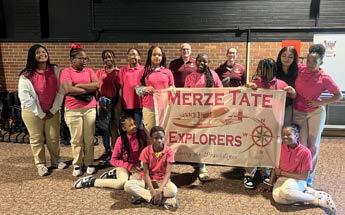
While driving around campus, we noticed red dresses on display but didn’t know what they meant. Once inside the museum, we learned that the red dress exhibits around campus were also in the museum. The red dresses raise awareness about the kidnapping and unsolved murders of Indigenous women, including some from tribes in the Mt. Pleasant area.
Martin shared that the murder rate of Indigenous women is three times higher than that of non-Indigenous women. He said 56.1% of Indigenous women experience sexual violence, and they are 1.7 times more likely to experience violence. Murder is the third leading cause of death for Indigenous women on tribal lands. Indigenous women face murder rates more than 10 times the national average, and homicide is the fifth-leading cause of death for Indigenous women aged 25 to 36.
After leaving the museum, Explorers thanked the instructors with Merze Tate Explorer swag. Everyone had learned something they would never forget.
Kennedy said, “One thing I liked about the museum was the stuffed animals—they were really interesting because they looked like real, live animals.”
The museum was a great experience and taught us about Michigan’s history, which we’ve grown to appreciate.

By Lena, Kaylee, and Niya
After a delicious lunch, the Explorers continued their journey through the streets of Mt. Pleasant toward the campus of Central Michigan University. We saw fraternity and sorority houses with large Greek-style letters on the front. Hundreds of basketball players were in town to compete in a Gus Macker competition. Graduates posed by CMU signs to celebrate their success. We visited the Bohannon Schoolhouse and the CMU Museum where we learned about the history of the campus and some famous graduates. Here are some fun facts.

* CMU was founded in 1892 as Central Normal School, a teacher training school.
* Around 28,389 students attend CMU each year.
* The current president of CMU is George E. Ross.
* CMU is known for its strong business and education programs.
* CMU has a nationally-recognized college of medicine.
* CMU offers over 2,000 academies for undergraduate, graduate, and doctoral degrees.
* CMU is one of the nation’s 100 largest universities.
* The mascot for CMU is the Bearcat.
* Eric Fisher and Jay Beckman are two famous CMU alumni.

Find the hidden names of the countries.
Match the place Explorers have visited to its country flag. BONUS: Name the country associated with the flag.







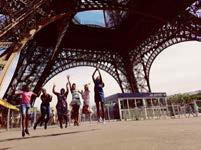









Country

























Who is Michigan’s first African American Michigan Supreme Court Justice? (page 11)
Who is Michigan’s first African American Michigan Supreme Court Justice? (page 11)
Who is Michigan’s first African American Michigan Supreme Court Justice? (page 11)
Who is Michigan’s first African American Michigan Supreme Court Justice? (page 11)
Who is Michigan’s first African American Michigan Supreme Court Justice? (page 11)
Who is Michigan’s first African American Michigan Supreme Court Justice? (page 11)
Who is Michigan’s first African American Michigan Supreme Court Justice? (page 11)
Who is Michigan’s first African American Michigan Supreme Court Justice? (page 11)
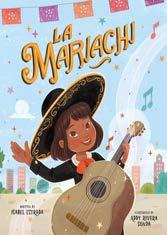
Which London landmark is on the Top 5 Explorer list? (page 22)
Which London landmark is on the Top 5 Explorer list? (page 22)
Which London landmark is on the Top 5 Explorer list? (page 22)
Which London landmark is on the Top 5 Explorer list? (page 22)
Which London landmark is on the Top 5 Explorer list? (page 22)
Which London landmark is on the Top 5 Explorer list? (page 22)
Which London landmark is on the Top 5 Explorer list? (page 22)




YOUR KNOWLEDGE
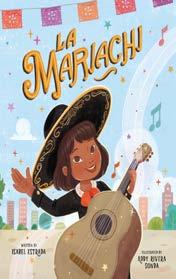
YOUR KNOWLEDGE On which Michigan college campus is the historic Bohannon Schoolhouse located? (page 14)
(page 14)
(page 14)
The author of this book first desired a life as a... (page 13)
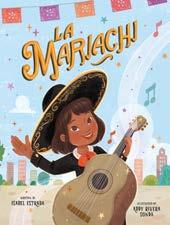
The author of this book first desired a life as a... (page 13)
The author of this book first desired a
The author of this book first desired a life as a... (page 13)
The author of this book first desired a life as a... (page 13)
as a... (page 13)
The author of this book first desired a life as a... (page 13)
The author of this book first desired a life as a... (page 13)
The author of this book first desired a life as a... (page 13)







What relaxing activity led Explorers down a river in Oxford? (page 29)

Which London landmark is on the Top 5 Explorer list? (page 22) What relaxing activity led Explorers down a river in Oxford? (page 29)
(page 29)
What relaxing activity led Explorers down a river in Oxford? (page 29)
What relaxing activity led Explorers down a river in Oxford? (page 29)
(page 29)
relaxing activity led Explorers down a river in Oxford? (page 29)







Season Press, LLC is thrilled to announce the launch of our brand-new Community Voices / Youth Voices book series! This exciting imprint is all about spotlighting fresh, powerful stories from young, inspiring authors ages 8-18. Youth Voices books highlight Season Press authors who empower, inspire, and educate youth to make a difference in their communities and beyond.
A HUGE congratulations to our amazing writers who are the voice of the next generation!
Learn more about upcoming Community Voices/Youth Voices workshops, competitions, and more at seasonpressinc.com.


